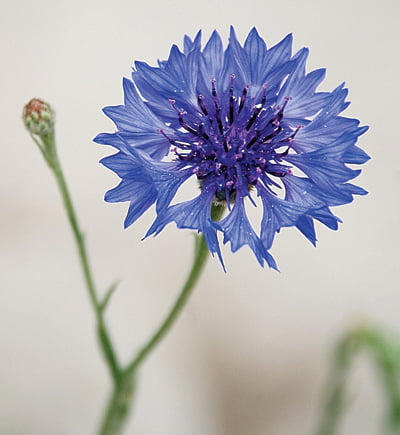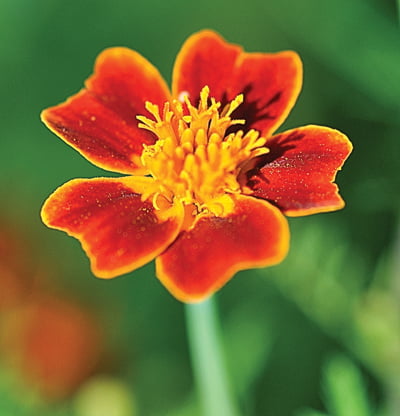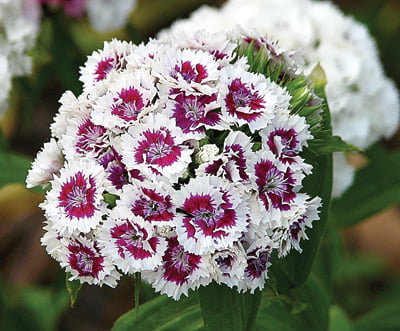


Laura Dean Bennett
Staff Writer
It’s best to say right up front, there are many inedible flowers in nature – prettier to look at than truly good tasting or safe to eat.
But that being said, there are lots of flowers which can be as much a feast for your taste buds as your eyes.
Flowers are truly one of nature’s greatest gifts.
Outdoors, they provide food for bees and hummingbirds.
Indoors, they provide sustenance to humans.
As you’re planting your kitchen gardens and flower beds this spring, don’t forget that many flowers can do double duty on your dining room table as beautiful décor and also as something exotic on the menu.
Most blossoms and petals are very delicate and don’t take handling well, nor do they do well with being washed.
You’ll want to pick them just before you are ready to use them, brush or dust off any dirt on them, always checking for insects which may be present.
And the most important caution – never eat any flowers which have come from a florist.
Only cook, eat or garnish with flowers grown at home which you know have never been sprayed with any chemicals.
If you like annuals, plant arugula, bachelor buttons, calendulas, dill, dwarf scarlet runner beans, nasturtiums, pansies, squash, dwarf sunflowers or violas.
Arugula blossoms have a crepe paper-like texture and, like arugula leaves, taste nutty and spicy. They’re great over salads or as a garnish.
Bachelor buttons (aka cornflowers) smell peppery and, a bit like cloves, have a subtle taste of sweet spiciness.
Dill is always a favorite in any herb garden. But its flowers are good for more than making a pretty and pungent addition to jars of pickles. Their taste is a stronger version of the taste of the dill leaf. They make a pretty garnish in a drink, on top of a bowl of soup or on a plate – say beside a piece of fish.
Dwarf scarlet runner beans are attractive, quick-growing ornamental climbers beloved by hummingbirds and butterflies and grown in English and early American gardens since the 17th century. The beans are delicious and also dry well, the flowers make cheerful garnish in salads and the roots may also be eaten.
Marigolds – citrus flavored varieties – especially Lemon Gem or Tangerine Gem – have a refreshing, citrusy taste, unlike many of their other, more common cousins which tend towards bitterness.
Nasturtium blossoms have a peppery watercress flavor – great as additions to salads and sandwiches.
Pansy and viola blossoms have a light, sweet taste which complement so many dishes and desserts. Pansy blossoms make a lovely accompaniment to salads and vegetable dishes, and cakes take on an air of sophistication when viola blossoms decorate the icing.
Squash have both male and female blossoms on the same plant – both are edible and taste like a faint version of squash. They’re delicious stuffed with cheese or added to a quesadilla. Pick the blossoms in the morning as they just begin to open.
Not as fragile as most flowers, they will store well for a couple of days in the fridge if placed in a plastic bag lined with a damp paper towel. You can eat the blossoms of any summer or winter squash, including pumpkins.
If it’s perennials you prefer – try growing bergamot (aka wild bee balm), calendula, dianthus, hollyhocks, lavender, sweet violets or roses.
Both the leaves and flowers of bergamot are edible. The flowers make an attractive edible topping in salads and are also brewed into an aromatic tea.
Calendula (aka pot marigold) is a prodigious producer from spring through fall. Nip off faded blooms to encourage new blossoms to form. The flowers are most fetching scattered on top of a salad or around the edge of a plate.
At the end of the growing season, let some of the flowers go to seed, as calendula self-sows readily, meaning it will faithfully return on its own next spring.
Dianthus flowers (miniature versions of carnations) offer up a scent that’s peppery and something like a combination of nutmeg and cloves and their petals have been used for centuries by French monks in the making of the liqueur known as Chartreuse.
They lend themselves well to garnishes on salads, vegetables and cakes. Chop petals and mix into softened butter with other herbs and spread on vegetables or meat – this goes especially well with lamb.
Hollyhocks’ mild, neutral flavor comes in handy for use in salads, sandwiches or as dramatic garnishes. Hollyhock petals come in all sorts of rich colors, from bright white to deep mahogany, and they can have many culinary uses.
They make a colorful addition or alternative to lettuce, a wholesome sandwich partner and a noteworthy garnish on any entrée or dessert plate.
Lavender has many uses in the kitchen and throughout the home. Its buds and blooms are used to flavor many savory dishes. Lavender is a member of the mint family, similar to rosemary, sage and thyme. It’s used in cooking and as garnishes in salads, on vegetable dishes and for desserts. The taste can be strong and so the flowers are used sparingly.
Violets are used by cooks and bakers in many ways. They enhance soups and baked desserts and make wonderful syrups.
Roses can not only be used as decoration on sandwich and dessert plates but they also enhance many desserts.
They can also garnish salads, iced tea and cocktails.
For cooking, there are three types of roses recommended – rugosa, hybrid teas and miniatures – all will do well in the gentle hands of an adventurous chef.
One of the most glorious aspects of spring is the return of flowers.
And they offer us a feast for our palates as well as our senses.
Rose Petal Tea Sandwiches
1 loaf sliced white bread
2 Tbsp. butter, softened
3 oz. cream cheese, softened
18-24 rose petals, with the white ends trimmed off
Red rose petals make the most dramatic sandwiches, but any rose petals will do as long as they have not come from a florist.
Be sure to use only roses grown at home and never sprayed with chemicals.
Rinse the rose petals and set them aside to dry on a towel.
Using a cookie cutter, cut the bread into flower shapes, avoiding cutting onto the crusts. If you don’t have a flower-shaped cookie cutter, you may cut the bread into round shapes with a drink glass.
Lightly butter the bread, and spread approximately 1 tsp. of cream cheese on each sandwich. Garnish each sandwich one rose petal (or more – perhaps three – if using miniature roses) onto each open-faced sandwich.
As a variation, you may chop the rose petals and blend them into the cream cheese.
Serve on a special serving tray lined with a doily.
Marigold Rice
Citrus flavored marigolds (Lemon Gem or Tangerine Gem) will not only make a lovely garnish for rice or pasta, but can actually change its flavor.
Marigold rice makes a remarkable side dish and marigold-garnished pasta makes a lovely first course.
1 cup long-grain white rice
1 tsp. olive oil
1/4 tsp. salt
About 1/2 cup of Lemon Gem or Tangerine Gem marigold petals, plus 1/4 cup whole flowers, for garnish
Bring 2 cups of water to a boil in a medium pot with a lid. Add the rice, oil and salt. Cover, lower the heat and simmer for 20 minutes, until rice is fluffy, not sticky. Do not overcook the rice. Transfer the rice to a platter and sprinkle marigold petals generously over the rice. Garnish with whole flowers and serve immediately.
If using pasta, follow usual directions for cooking the pasta and then drain thoroughly. Return pasta to the pot and place over low heat for a few seconds. Toss with 2 Tbsp. of olive oil and 1 tsp. minced garlic, transfer onto platter, sprinkle with marigold petals, garnish with marigold flowers and serve immediately.
Viola
(or Johnny-Jump-Up) Cream Puffs
This dessert is fit for royalty, and your family will love it too.
Cream Puffs
1/2 cup milk or water
1/4 cup unsalted butter
1/2 cup all purpose flour
Pinch of salt
2 eggs
Viola Cream Filling
1 cup heavy cream
3 Tbsp. confectioner’s sugar
1/4 tsp. vanilla extract
Pinch of ground ginger
1 cup viola or Johnny-jump-up flowers, stems removed
1/2 cup chocolate sauce
1/2 cup viola flowers, for garnish
Preheat oven to 425 degrees.
Make the puffs: In a large saucepan over medium high heat, bring milk and butter to a boil. Slowly add the flour and salt to the milk, stirring constantly. While stirring, cook the batter until it leaves the sides of the pot, then remove from heat. Beat in one egg at a time.
Grease a cookie sheet, then spoon the batter into mounds onto the sheet, leaving about three inches between them. If you want six very large puffs, make the mounds larger. For smaller puffs, make the mounds smaller. The batter can also be pressed through a pastry tube if you want éclairs.
Bake until the tops of the puffs start to turn golden brown, about 10 minutes, then reduce heat to 350 degrees and continue baking for about 20 to 25 minutes.
You have to watch the puffs carefully at this stage so they do not burn. Test puffs by removing one from the oven. If it doesn’t collapse, they are done. Remove them immediately, and let cool on a rack.
Make the filling: Whip the heavy cream, sugar and vanilla until stiff. Fold in ginger until well blended. Very gently fold in 1 cup flowers.
Assemble the puffs: Use a sharp, small knife to slice into the puffs, but do not cut them completely in half. Remove any moist interior to make a hollow. Spoon the filling into each puff and place on individual plates or on a serving platter. Drizzle lightly with chocolate sauce. Garnish with 1/2 cup viola flowers.
Recipes from: A Garden of Recipes – Planting, Growing, Cooking by Cynthia Gibson – a lovely book.
Available from amazon.com


